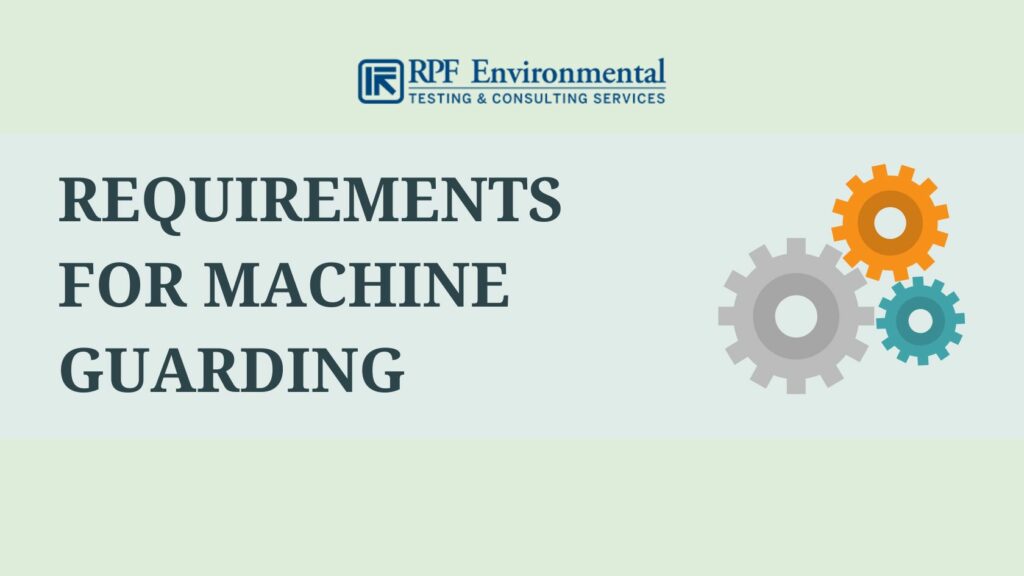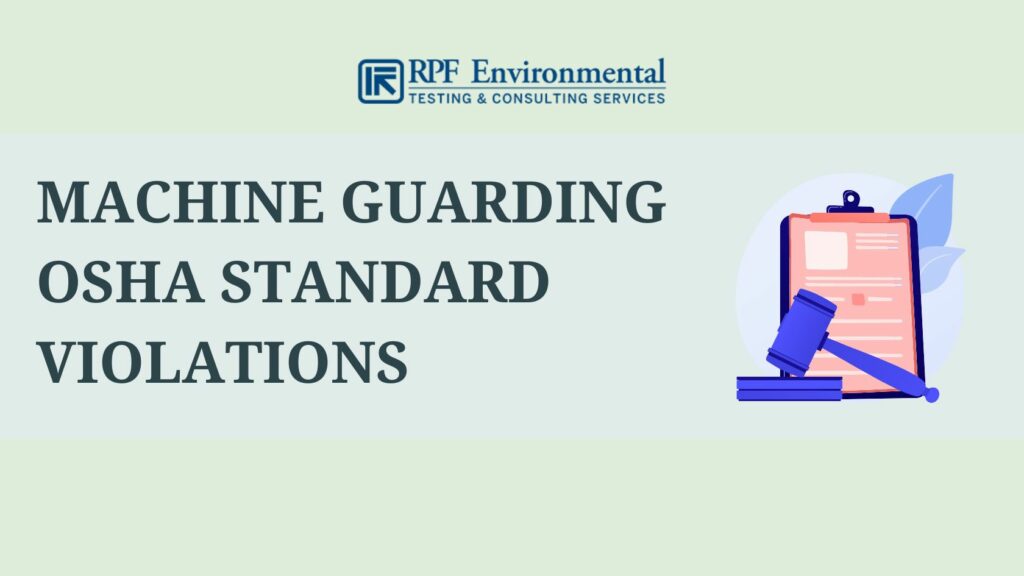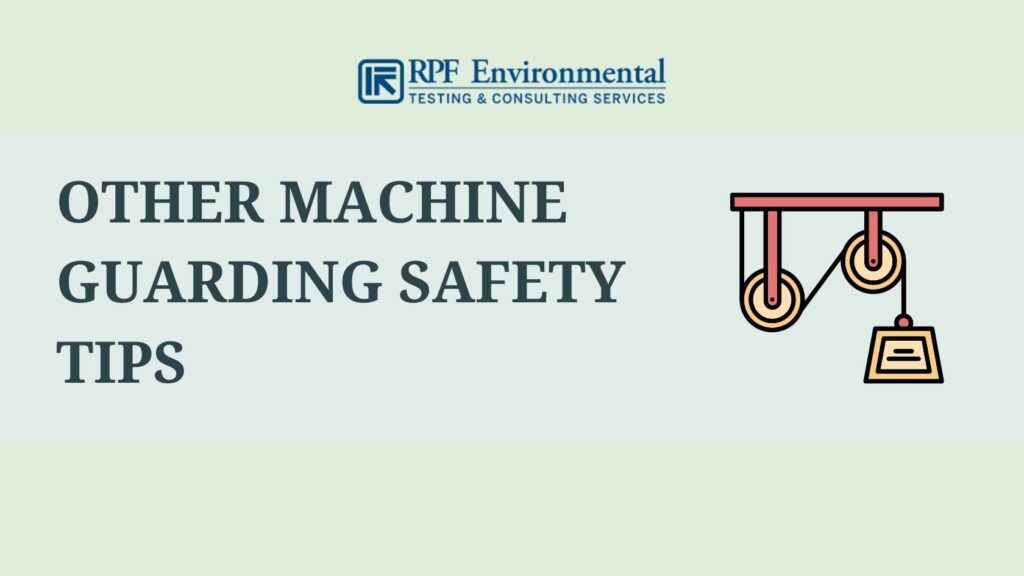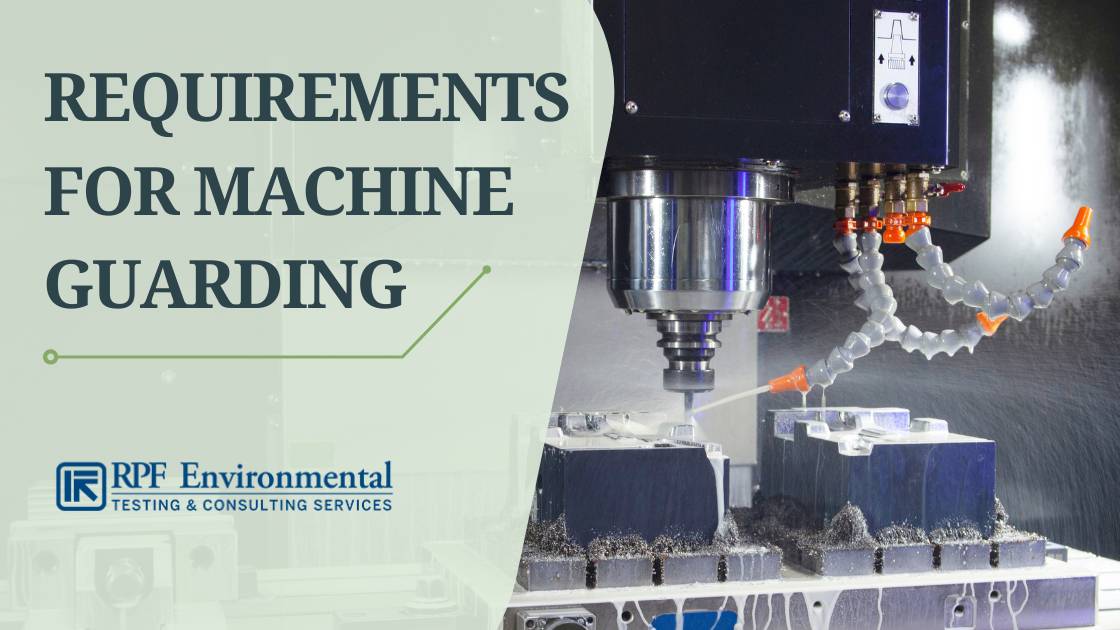Many moving parts of a machine create hazards and can cause serious injuries including amputations. This is why the Occupational Safety and Health Administration (OSHA) have set strict requirements for machine guarding to emphasize its importance in promoting workplace safety.
But despite this, machine guarding is still part of the top 10 OSHA violations. So to help you avoid violations and make an informed decision in implementing safeguards and procedures in your workplaces, we’ve written this article.
RPF Environmental helps companies in the New England region and across the nation stay in compliance.
What is OSHA Machine Guarding?
| According to OSHA | |
| “Employee exposure to unguarded or inadequately guarded machines is prevalent in many workplaces. Consequently, workers who operate and maintain machinery suffer approximately 18,000 amputations, lacerations, crushing injuries, abrasions, and over 800 deaths per year. Amputation is one of the most severe and crippling types of injuries in the occupational workplace, and often results in permanent disability.” (Source) | Heavy-duty machines like power presses, milling machines, shears, power saws, guillotine cutters, conveyor belts, and revolving drums can cause serious injuries. They can crush or even tear off the operator’s body parts. In-running pinch or nip points (e.g. gears, calenders, spoked hand wheels, and other rotating parts) as well as flying debris and sparks can also cause injuries. |
Machine safety guarding systems are protection mechanisms and barriers that a company installs to prevent worker injuries. OSHA has also set machine guarding requirements for specific equipment which we will discuss more in detail later.
1. General Machine Safeguarding Requirements

You should safeguard any component, process, or function in a machine that can cause potential injury. You can find OSHA’s general machine safety standards in 29 CFR 1910 Subpart O, Machinery and Machine Guarding.
A. Types of Machine Safety Guarding Systems
OSHA states that:
“One or more methods of machine guarding shall be provided to protect the operator and other employees in the machine area from hazards such as those created by point of operation, ingoing nip points, rotating parts, flying chips, and sparks.” – General requirements for all machines. OSHA 1910.212(a)(1)
There are 5 major classifications of machine safety systems that you can use:
- Guards – Physical barriers that enclose hazardous components
- Devices – Use controls and sensors to prevent risks
- Safeguarding by Machine Location & Distance – Positioning dangerous components of a machine in a way that they won’t cause any hazard
- Automated Feeding & Ejection Methods – Using robots to perform repeating tasks like loading, unloading, transferring objects, and assembling parts
- Miscellaneous Aids – Examples are awareness barriers, protective shields, and hand-feeding tools
You can read more about these types in detail in our types of machine safeguarding article.
B. Point of Operation Machine Guarding Requirements
Points of operation in a machine that expose an operator to injury should be guarded. The machine safety device should conform to appropriate standards as well. But in general, they should be designed in such a way that the operator won’t need to expose any body part in the hazard zone while the machine is operating.
What is a Point of Operation?
Machine guarding mostly applies to points of operation in a machine which are the locations where the machine performs its tasks like drilling, cutting, and boring. There can be one or more points of operation in a machine that you all need to safeguard. There are also instances when you are required to install secondary safeguards like fences and alarms to enhance safety.
Types of Machines That Require Point of Operation Guarding
Here are some machines that usually need point-of-operation guarding:
- Portable power tools
- Power saws
- Milling machines
- Power presses
- Jointers
- Alligator presses
- Shears
- Guillotine cutters
- Forming rolls
C. Machines That Require Require Specific Guarding Standards
Furthermore, there are machines that have specific safeguarding standards as listed below:
- Machines in fixed locations should be anchored securely to prevent them from moving.
- Fan blades with peripheries that are 7 feet or less above the working level or floor should be safeguarded with guards with utmost ½-inch openings.
- You should guard revolving drums, containers, and barrels with enclosures that are interlocked with drive mechanisms so they won’t revolve if the guard is not in place.
NOTE: Since OSHA’s requirements for machine guarding do not cover every specific equipment type, we also refer to ANSI B11.19-2010: Performance Requirements For Safeguarding. The American National Standards Institute’s (ANSI’s) standards are helpful for vague OSHA standards and types of machines that are not listed in their requirements.
D. Machine Guard Standards
As for machine safety systems, there are also standards that you need to follow when installing them. They should:
- Prevent Contact – Guards must prevent the arms, hands, and any body part of the operator from making direct contact with hazardous moving parts.
- Secured in Place – They should be secured in place firmly as well as constructed to be strong and durable so they can withstand normal use and can’t be easily tampered with, bypassed, or removed.
- Not Create New Hazards – They shouldn’t create new hazards like shear or pinch points and shouldn’t have jagged edges and unfinished surfaces that can cause lacerations. They shouldn’t also obstruct the worker’s view.
- Allow for Safe Lubrication – They should allow the machine to be lubricated without removing the guards.
- Not Interfere With Machine Operations – Guards that interfere with machine operations might be disregarded or overridden sooner or later. Thus, make sure that they enhance efficiency rather than slow down your operations.
- Prevent other objects from getting into the moving parts
- Have openings that are small enough to prevent access to the danger areas
For machine guard construction and materials, here are the important things you should know:
Guard Construction
- Manufacturer-Designed Guards: It is desirable for the machine manufacturer to design and install the guard themselves to ensure that the guard conforms with the machine’s function and design. This way, it is easier to construct the guard to strengthen or add additional functions to the machine.
- User-Built Guards: You can also build the guards yourself, especially when you are using older machines. This provides more flexibility when it comes to changing situations and provides you with more design options. Also, guards designed and installed by your own workers give your workers better knowledge when it comes to operating the guards.
NOTE: The only drawback of user-built guards is that they might not work well with the machine’s function and configuration, especially if they are poorly designed. This may cause machine guarding accidents that can lead to serious injuries.
Materials Requirements
Machine safety systems can be made of wood, metal, plastic, or other materials that can withstand prolonged use and impact. Metal is used in many circumstances, but you can also use plastic for applications that require higher visibility. On the other hand, wood guards are not generally recommended as they are flammable and not durable.
However, Section 1910.219 Mechanical power-transmission apparatus mentioned that you can use wood guards in industries that cause metal guards to deteriorate rapidly. These industries include the chemical and woodworking industries. You can also use wood in construction works and locations exposed to extreme cold or heat where metal guards are undesirable.
2. Construction Industry Requirements

OSHA requires all power and hand tools along with other similar equipment to be safeguarded as well as maintained in safe conditions. You should guard construction equipment if they are exposed to worker contact along with moving, reciprocating, and rotating parts. These include:
- Belts
- Gears
- Sprockets
- Spindles
- Shafts
- Pulleys
- Drums
- Chains
- Flywheels
In addition, OSHA also states that safeguards must meet ANSI Safety Code for Mechanical Power-Transmission Apparatus. B15.1-1953 (R1958) requirements. Employers should also ensure that the operators using power and hand tools wear PPE to protect themselves against:
- Falling, flying, splashing, and abrasive objects
- Harmful fumes, dust, mists, gasses, and vapors
Machine Guarding OSHA Standard Violations

As we’ve mentioned earlier, OSHA machine safeguarding violations are among the top 10 OSHA violations when it comes to workplace safety.
Why Violations Happen:
- Not all machines have the required safe controls installed.
- Not all machine manufacturers provide built-in guards.
- User-built safeguards might be poorly built and don’t work well with the machine.
- Inadequate operator training and human error (e.g. overlooking safety precautions or pressing the wrong buttons) which can lead to accidents.
Possible Loses When You Violate OSHA Machine Guarding Requirements
OSHA violation penalties cost $14,502 per violation but repeated or willful violations can cost you $145,027 per violation.
Other costs you may need to pay include worker compensation claims, safeguard and machinery replacements, legal fees, and your company’s reputation.
Avoiding OSHA Machine Guarding Standard Violations
If you don’t want to incur losses in your business, a few signs you should look out for include working with too many machines (especially if they are old ones), not giving proper training to your employees, and not inspecting your machines regularly.
As for ways to avoid OSHA violations, here are some tips you can follow aside from providing adequate training to machine operators:
- Identify all hazards in your machines and assess risks
- Install enough safeguards on all of your machines’ hazardous components including miscellaneous aids
- Have a lockout/tagout system in place for machine maintenance and servicing
- Inspect your machines regularly
Other Machine Guarding Safety Tips

Below are other safety tips you can follow:
- You can purchase safeguards from your machine’s manufacturer, but make sure that they comply with OSHA’s requirements, especially the ones purchased overseas
- Make sure a qualified professional designs and builds your safeguard if you are planning to build them yourself
- Consider machine guarding when evaluating new machine purchases
FAQs
Yes, OSHA requires employers to provide adequate employee and safeguarding training to prevent serious machine injuries.
These are the points of operation, power transmission apparatus, and operating controls:
1. Point of Operation – points where machine tasks are performed (e.g. shaping, boring, cutting)
2. Power Transmission Apparatus – All components that transmit energy (e.g. gears, cranks, flywheels, belts, pulleys, chains, cams, spindles, couplings, connecting rods)
3. Operating Controls – Other moving parts like transverse, reciprocating, and rotating parts including auxiliary and feed mechanisms
OSHA requires fan blades to use guards with ½-inch openings or smaller. In general, guard openings must be small enough that employees won’t be able to access danger areas.
Understand OSHA’s Machine Guarding Standards & Manage OSHA Compliance with the Help of RPF Environmental
Understanding OSHA requirements for machine guarding is a challenging task, but working with a trustworthy company that can help you better understand these requirements will make a big difference.
RPF Environmental’s professionals can help you with total machine guarding compliance by offering evaluations and risk assessment as well as comprehensive machine guarding implementation guidelines. We are proud to serve clients in New Hampshire, Maine, Massachusetts and areas across the nation.
Contact us for more details!




